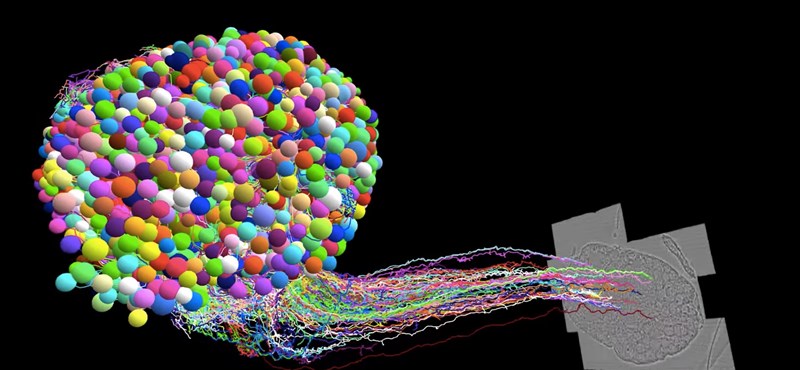[{“available”:true,”c_guid”:”ef02f444-c088-40a9-8c29-5ea2743361c8″,”c_author”:”hvg.hu”,”category”:”tudomany”,”description”:”A hétvége folyamán játékoscsúcsot döntött a CS:GO, 1,4 millió egyidejűleg aktív felhasználóval – a rekord néhány nappal azt követően dőlt meg, hogy kiderült, hamarosan újabb változat érkezhet a játékból.”,”shortLead”:”A hétvége folyamán játékoscsúcsot döntött a CS:GO, 1,4 millió egyidejűleg aktív felhasználóval – a rekord néhány nappal…”,”id”:”20230313_counter_strike_global_offensive_csgo_uj_rekord_jatekosszam_egyszerre_steam”,”image”:”https://api.hvg.hu/Img/ffdb5e3a-e632-4abc-b367-3d9b3bb5573b/ef02f444-c088-40a9-8c29-5ea2743361c8.jpg”,”index”:0,”item”:”cc9f9fbc-eadf-4c6f-8379-27e0d3e1c3ad”,”keywords”:null,”link”:”/tudomany/20230313_counter_strike_global_offensive_csgo_uj_rekord_jatekosszam_egyszerre_steam”,”timestamp”:”2023. március. 13. 23:03″,”title”:”11 évvel a megjelenése után most hétvégén 1,4 millió ember játszott egyszerre a Counter-Strike-kal”,”trackingCode”:”RELATED”,”c_isbrandchannel”:false,”c_isbrandcontent”:false,”c_isbrandstory”:false,”c_isbrandcontentorbrandstory”:false,”c_isbranded”:false,”c_ishvg360article”:false,”c_partnername”:null,”c_partnerlogo”:”00000000-0000-0000-0000-000000000000″,”c_partnertag”:null},{“available”:true,”c_guid”:”7c3d472c-8622-4a9c-b0c8-d6b0d9ef98f6″,”c_author”:”hvg.hu”,”category”:”gazdasag”,”description”:”Azoknak fognak fizetni a biztosítók, akiknek volt legalább kötelező biztosításuk és vétlennek bizonyulnak, a felelősség megállapítása azonban hónapokba fog telni a szombati tömegbaleset ügyében. A Magyar Biztosítók szövetsége ezért aktiválta a tömeges kárrendezési szabályozását, ami révén még a vizsgálatok lezárulta előtt kártérítési előleget fizetnek az azt igénylő érintetteknek. Azokkal, akiknek a vizsgálat végén mégis felmerül a felelőssége, utólag fognak elszámolni.”,”shortLead”:”Azoknak fognak fizetni a biztosítók, akiknek volt legalább kötelező biztosításuk és vétlennek bizonyulnak, a felelősség…”,”id”:”20230314_baleset_m1_tomegkarambol_karterites_magyar_biztositok_szovetsege_karrendezes”,”image”:”https://api.hvg.hu/Img/ffdb5e3a-e632-4abc-b367-3d9b3bb5573b/7c3d472c-8622-4a9c-b0c8-d6b0d9ef98f6.jpg”,”index”:0,”item”:”da78f796-f8d7-4f93-ba4c-bd4305e6e3c5″,”keywords”:null,”link”:”/gazdasag/20230314_baleset_m1_tomegkarambol_karterites_magyar_biztositok_szovetsege_karrendezes”,”timestamp”:”2023. március. 14. 05:07″,”title”:”Milyen kártérítésre számíthat, aki balesetet szenved egy olyan káoszban, mint a szombati?”,”trackingCode”:”RELATED”,”c_isbrandchannel”:false,”c_isbrandcontent”:false,”c_isbrandstory”:false,”c_isbrandcontentorbrandstory”:false,”c_isbranded”:false,”c_ishvg360article”:false,”c_partnername”:null,”c_partnerlogo”:”00000000-0000-0000-0000-000000000000″,”c_partnertag”:null},{“available”:true,”c_guid”:”5800fd48-9a32-4156-8150-3e6fca9a3b30″,”c_author”:”hvg.hu”,”category”:”cegauto”,”description”:”A normál mellett immár a kupés hangulatú felfrissített GLE is kapható hazánkban, akár 100 kilométert meghaladó elektromos hatótávval.”,”shortLead”:”A normál mellett immár a kupés hangulatú felfrissített GLE is kapható hazánkban, akár 100 kilométert meghaladó…”,”id”:”20230313_magyarorszagon_a_megujult_mercedes_gle_coupe”,”image”:”https://api.hvg.hu/Img/ffdb5e3a-e632-4abc-b367-3d9b3bb5573b/5800fd48-9a32-4156-8150-3e6fca9a3b30.jpg”,”index”:0,”item”:”f585ac1e-291c-4961-8f7f-59f72179fa5a”,”keywords”:null,”link”:”/cegauto/20230313_magyarorszagon_a_megujult_mercedes_gle_coupe”,”timestamp”:”2023. március. 13. 06:41″,”title”:”Magyarországon a megújult Mercedes GLE Coupé”,”trackingCode”:”RELATED”,”c_isbrandchannel”:false,”c_isbrandcontent”:false,”c_isbrandstory”:false,”c_isbrandcontentorbrandstory”:false,”c_isbranded”:false,”c_ishvg360article”:false,”c_partnername”:null,”c_partnerlogo”:”00000000-0000-0000-0000-000000000000″,”c_partnertag”:null},{“available”:true,”c_guid”:”e849e7c8-9508-408a-93fc-c1a234cd6f03″,”c_author”:”hvg.hu/MTI”,”category”:”gazdasag”,”description”:”Berlinben, Brémában, Hamburgban és Hannoverben sztrájkolnak a szakszervezetek. “,”shortLead”:”Berlinben, Brémában, Hamburgban és Hannoverben sztrájkolnak a szakszervezetek. “,”id”:”20230313_Sztrajk_miatt_megbenultak_a_legnagyobb_nemet_repterek”,”image”:”https://api.hvg.hu/Img/ffdb5e3a-e632-4abc-b367-3d9b3bb5573b/e849e7c8-9508-408a-93fc-c1a234cd6f03.jpg”,”index”:0,”item”:”2cadebd8-6010-424c-b31b-67fc9c94d3b5″,”keywords”:null,”link”:”/gazdasag/20230313_Sztrajk_miatt_megbenultak_a_legnagyobb_nemet_repterek”,”timestamp”:”2023. március. 13. 11:05″,”title”:”Megbénultak a legnagyobb német repterek, két budapesti járatot is töröltek”,”trackingCode”:”RELATED”,”c_isbrandchannel”:false,”c_isbrandcontent”:false,”c_isbrandstory”:false,”c_isbrandcontentorbrandstory”:false,”c_isbranded”:false,”c_ishvg360article”:false,”c_partnername”:null,”c_partnerlogo”:”00000000-0000-0000-0000-000000000000″,”c_partnertag”:null},{“available”:true,”c_guid”:”a1fd85b7-fb83-47ee-9014-1c7e7a2a5ab9″,”c_author”:”hvg.hu”,”category”:”cegauto”,”description”:”Feszegette a jármű határait a sofőr, mint egy versenyző, és gyorsan meg is találta. “,”shortLead”:”Feszegette a jármű határait a sofőr, mint egy versenyző, és gyorsan meg is találta. “,”id”:”20230313_Az_F1_leglassabb_kanyarja_a_monacoi_Loews_is_tul_nehez_volt_a_Citroen_miniautojanak_es_csunyan_felborult__video”,”image”:”https://api.hvg.hu/Img/ffdb5e3a-e632-4abc-b367-3d9b3bb5573b/a1fd85b7-fb83-47ee-9014-1c7e7a2a5ab9.jpg”,”index”:0,”item”:”676822e0-cb40-45ba-9acd-aa12b376ddbf”,”keywords”:null,”link”:”/cegauto/20230313_Az_F1_leglassabb_kanyarja_a_monacoi_Loews_is_tul_nehez_volt_a_Citroen_miniautojanak_es_csunyan_felborult__video”,”timestamp”:”2023. március. 13. 07:43″,”title”:”A Forma-1 leglassabb kanyarjában is sikerült látványosat borulni egy elektromos miniautóval – videó”,”trackingCode”:”RELATED”,”c_isbrandchannel”:false,”c_isbrandcontent”:false,”c_isbrandstory”:false,”c_isbrandcontentorbrandstory”:false,”c_isbranded”:false,”c_ishvg360article”:false,”c_partnername”:null,”c_partnerlogo”:”00000000-0000-0000-0000-000000000000″,”c_partnertag”:null},{“available”:true,”c_guid”:”019ca44a-6706-4d03-b729-3406c2376592″,”c_author”:”MTI / hvg.hu”,”category”:”cegauto”,”description”:”Az Útinform azt kéri, hogy aki teheti, a megnövekedett menetidő miatt válasszon másik útvonalat. “,”shortLead”:”Az Útinform azt kéri, hogy aki teheti, a megnövekedett menetidő miatt válasszon másik útvonalat. “,”id”:”20230313_utburkolatot_is_cserelni_kell_a_szombati_tomegbaleset_helyszinen”,”image”:”https://api.hvg.hu/Img/ffdb5e3a-e632-4abc-b367-3d9b3bb5573b/019ca44a-6706-4d03-b729-3406c2376592.jpg”,”index”:0,”item”:”abf0b9c5-d613-4924-9780-3870b94c9ec3″,”keywords”:null,”link”:”/cegauto/20230313_utburkolatot_is_cserelni_kell_a_szombati_tomegbaleset_helyszinen”,”timestamp”:”2023. március. 13. 10:23″,”title”:”Cserélik az útburkolatot, 10 kilométeres a torlódás a szombati tömegbaleset helyszínén”,”trackingCode”:”RELATED”,”c_isbrandchannel”:false,”c_isbrandcontent”:false,”c_isbrandstory”:false,”c_isbrandcontentorbrandstory”:false,”c_isbranded”:false,”c_ishvg360article”:false,”c_partnername”:null,”c_partnerlogo”:”00000000-0000-0000-0000-000000000000″,”c_partnertag”:null},{“available”:true,”c_guid”:”d571d203-9f58-4697-a469-d3d983f94d13″,”c_author”:”hvg.hu”,”category”:”itthon”,”description”:”Az egykori kvízmester arra utalt, hogy a DK hegyvidéki önkormányzati képviselőjeként nem él kifejezetten jól.”,”shortLead”:”Az egykori kvízmester arra utalt, hogy a DK hegyvidéki önkormányzati képviselőjeként nem él kifejezetten jól.”,”id”:”20230313_Vago_Istvan_a_nyugdija_felet_kolti_a_rezsiszamlakra”,”image”:”https://api.hvg.hu/Img/ffdb5e3a-e632-4abc-b367-3d9b3bb5573b/d571d203-9f58-4697-a469-d3d983f94d13.jpg”,”index”:0,”item”:”2c8a5c51-a18d-4350-a227-a40afdb6da9f”,”keywords”:null,”link”:”/itthon/20230313_Vago_Istvan_a_nyugdija_felet_kolti_a_rezsiszamlakra”,”timestamp”:”2023. március. 13. 06:39″,”title”:”Vágó István nyugdíjának a felét elviszik a rezsiszámlák”,”trackingCode”:”RELATED”,”c_isbrandchannel”:false,”c_isbrandcontent”:false,”c_isbrandstory”:false,”c_isbrandcontentorbrandstory”:false,”c_isbranded”:false,”c_ishvg360article”:false,”c_partnername”:null,”c_partnerlogo”:”00000000-0000-0000-0000-000000000000″,”c_partnertag”:null},{“available”:true,”c_guid”:”1fcda308-8cff-4931-bff1-25b0a1768b3d”,”c_author”:”hvg.hu”,”category”:”cegauto”,”description”:”Többen megsérültek.”,”shortLead”:”Többen megsérültek.”,”id”:”20230312_Harom_auto_utkozott_Monornal_egy_ember_meghalt”,”image”:”https://api.hvg.hu/Img/ffdb5e3a-e632-4abc-b367-3d9b3bb5573b/1fcda308-8cff-4931-bff1-25b0a1768b3d.jpg”,”index”:0,”item”:”5d5655b0-3d75-4692-8b1b-3614e41556aa”,”keywords”:null,”link”:”/cegauto/20230312_Harom_auto_utkozott_Monornal_egy_ember_meghalt”,”timestamp”:”2023. március. 12. 21:20″,”title”:”Három autó ütközött Monornál, egy ember meghalt”,”trackingCode”:”RELATED”,”c_isbrandchannel”:false,”c_isbrandcontent”:false,”c_isbrandstory”:false,”c_isbrandcontentorbrandstory”:false,”c_isbranded”:false,”c_ishvg360article”:false,”c_partnername”:null,”c_partnerlogo”:”00000000-0000-0000-0000-000000000000″,”c_partnertag”:null}]


Order the weekly HVG newspaper or digitally and read us anywhere, anytime!
That’s why we ask you, our readers, to support us! We promise to keep doing the best we can!
We recommend it from the first page








